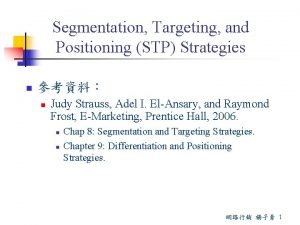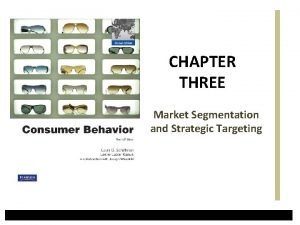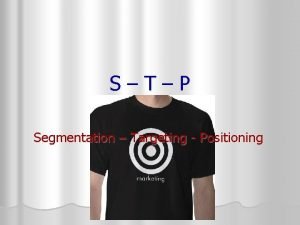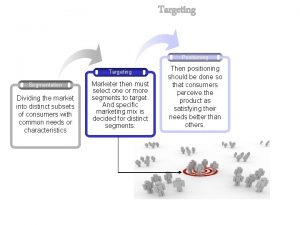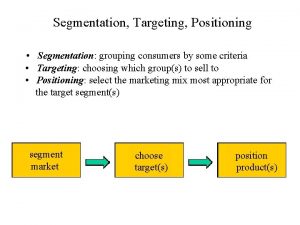Market segmentation targeting and positioning Markets Organisations that









































- Slides: 41

Market segmentation, targeting and positioning

Markets • • Organisations that sell to consumer and business markets recognise that they cannot appeal to all buyers in those markets, or at least not to all buyers in the same way. Buyers are too numerous, too widely scattered and too varied in their needs and buying practices. Different companies vary widely in their abilities to serve different segments of the market. Rather than trying to compete in an entire market, sometimes against superior competitors, each company must identify the parts of the market that it can serve best.

Three stages of marketing • Mass marketing – In mass marketing, the seller mass produces, mass distributes and mass promotes one product to all buyers. • Product-variety marketing – Here, the seller produces two or more products that have different features, styles, quality, sizes and so on. • Target marketing – Here, the seller identifies market segments, selects one or more of them, and develops products and marketing mixes tailored to each.

Markets • Firms moving from mass marketing and product-variety marketing to target marketing – More efficient form of marketing • Greater market fragmentation has brought about micro-marketing—targeting programs to needs and wants of narrowly defined segments – Customised marketing is the ultimate form

Steps in market segmentation, targeting and positioning

Three major steps in target marketing 1. 2. 3. Market segmentation – Dividing a market into distinct groups of buyers with different needs, characteristics or behaviours who might require separate products or marketing mixes. Market targeting – Evaluating each market segment’s attractiveness and selecting one or more of the market segments to enter. Market positioning – Setting the competitive positioning for the product and creating a detailed marketing mix.

Market segmentation • Markets consist of buyers, and buyers differ in one or more ways. – They may differ in their wants, resources, locations, buying attitudes and buying practices. – Because buyers have unique needs and wants, each buyer is potentially a separate market. – Ideally, then, a seller might design a separate marketing program for each buyer. – Most sellers face larger numbers of smaller buyers and do not find complete segmentation worthwhile; instead, they look for broad classes of buyers who differ in their product needs or buying responses.

Bases for segmenting consumer markets (1) • Geographic: dividing a market into different geographical units such as nations, regions, states, municipalities, cities or neighbourhoods. • Demographic: dividing the market into groups based on variables such as age, gender, family size, family life cycle, income, occupation, education, religion, race and nationality.

Bases for segmenting consumer markets (2) • Age and life-cycle stage: consumer needs and wants change with age, so some companies use age and life-cycle segmentation which divides a market based on age and life-cycle groups. • Gender: long used in clothing, cosmetics and magazines. Other opportunities include finance and cars, amongst others.

Bases for segmenting consumer markets (3) • Income: used in goods and services such as cars, boats, clothing and travel. • Multivariate demographic: most companies segment a market by combining two or more demographic variables.

Bases for segmenting consumer markets (4) • Psychographic: buyers are divided into different groups based on psychological/personality traits, lifestyle or values. People in the same geo-demographic group can have different profiles. • Behavioural: divides buyers into groups based on their knowledge of the product, their attitude towards it, the way they use it and their responses to it. • Benefits sought: buyers are segmented according to the different benefits they seek from the product.

Bases for segmenting consumer markets (5) • User status: many markets can be segmented into on-users, exusers, potential users, first time users and regular users of a product. • Usage rate: markets can also be segmented into light, medium and heavy user groups. • Loyalty status: a market can be segmented by consumer loyalty, divided according to their degree of loyalty. • Buyer-readiness stage: there are different stages of readiness to buy a product. Some people are aware, some are informed, some are interested, some want the product, and some intend to buy. • Attitude towards the product: people can be enthusiastic, positive, indifferent, negative or hostile.

Bases for segmenting business markets • Industrial markets can be segmented using many of the same variables used in consumer market segmentation: geographic, benefits sought, user status, user rate, loyalty status, readiness state and attitude. • Industrial companies usually use a combination of many segmentation methods, e. g. which end-use market to serve, product application, customer size, benefit groups, etc.

Segmenting international markets • Companies segment international markets using a combination of several variables: – Geographic location – Economic factors – Political and legal factors – Cultural factors – Inter-market segmentation

Requirements for effective segmentation • There are many ways to segment a market, but not all segmentations are effective. To be useful, market segments must rate favourably on five key criteria: – Measurable—the size and purchasing power of the segments must be able to be measured. Certain segmentation variables are difficult to measure. – Accessible—the segments must be able to be reached and served.

Requirements for effective segmentation – Substantial—the segments must be large or profitable enough. A segment should be the largest possible homogeneous group worth going after with a tailored marketing program. – Differentiable—the segments must be conceptually distinguishable and respond differently to different marketing mix elements and programs. – Actionable—effective programs must be able to be designed for attracting and serving the segments.

Marketing targeting • Market segmentation reveals the market segment opportunities facing a firm. • The firm now has to evaluate the various segments and decide on the number of segments to cover and the ones to serve. This is selecting target segments.

Evaluating market segments • Segment size and growth – The company must first collect and analyse data on current dollar sales, projected sales growth rates and expected profit margins for the various segments. It wants to select segments that have the right size and growth characteristics, but ‘right size growth’ is a relative matter. • Segment structural attractiveness – A segment might have desirable size and growth and still not be attractive from a profitability point of view. The company must examine several major structural factors that affect long-run segment attractiveness—e. g. concentration of market power

Evaluating market segments • Company objectives and resources – Even if a segment has positive size growth and is structurally attractive, the company must consider its own objectives and resources in relation to that segment. – Some attractive segments could be quickly dismissed because they do not mesh with the company’s long-run objectives.

Selecting market segments • After evaluating different segments, a company hopes to find one or more market segments worth entering. It must then decide which, and how many segments to serve. • A target market consists of a set of buyers sharing common needs or characteristics that the company decides to serve. The company can adopt one of three market-coverage strategies: – Undifferentiated marketing – Differentiated marketing – Concentrated marketing

Market-coverage strategies

Undifferentiated marketing • Ignores market segment differences • Chases whole market with one market offer—focussing on what is common in terms of needs • Relies on mass distribution and mass advertising of a ‘superior’ product • Costs minimised—inventory, narrow product range, advertising, market research • Heavy competition if other major competitors pursue same market

Differentiated marketing • Targets several market segment with a market offer for each segment • Aim is to have the ‘best’ offer in each segment, hence, gain higher sales and stronger position • Generally generates greater sales than undifferentiated approach BUT costs of doing business are higher— product modifications, market research, manufacturing, separate marketing plans, advertising and so on

Concentrated marketing • Appeals when resources limited • Pursue large share of one or few segments • Generally a good way for smaller firms to gain a foothold in a market • Firms have greater knowledge of their customers’ needs • Operational efficiencies due to specialisation in production, distribution and promotion • Riskier strategy—‘all eggs in one basket’

Choosing a market-coverage strategy • There are many factors to consider when choosing a market-coverage strategy. This has moved from mass marketing to direct to oneto-one marketing. • Permission marketing has emerged, which is ‘a process of converting strangers into friends and friends into customers. ’

Permission marketing • Permission marketing is based on prospective customers giving their permission for the marketer to communicate with them. • The basis is consumer benefit and permission can be revoked and cannot be transferred.

Permission marketing • There are four tests for permission marketing: • • Do your marketing efforts facilitate a learning relationship with your customer? Do you have a permission database to track those who have agreed to communicate? Do you have a script to educate people about your products or services? Once you have a customer, do you work to deepen your permission to communicate with them?

Which is the best strategy? • Company resources • Product variability—uniform products (steel, grapefruit) suits undifferentiated • Product life cycle stage—growth stage suits undifferentiated or concentrated, differentiated suits mature stage • Market variability (consumer tastes)—greater then differentiated • Competitors’ marketing strategies— segmentation requires differentiation

Market positioning • Once a company has decided which segments of the market it will enter, it must decide which ‘positions’ it wants to occupy in those segments. • Product position is the way the product is defined by consumers on important attributes —the place the product occupies in consumers’ minds is relative to competing products.

Positioning strategies • Marketers can follow several positioning strategies: – Positioning on specific product attributes such as price and performance. – A product can be positioned against a competitor. – A product can be positioned for different product classes, e. g. some margarines are positioned against butter and others against cooking oils.

Choosing and implementing a positioning strategy • Some firms find it easy to choose a positioning strategy (BMW—drive excitement) , but in many cases, two or more firms (Mercedes and Jaguar) will go after the same position. – Then, each will have to find other ways to set itself apart—post-sale service, technology.

Identifying a positional direction • A cornerstone of brand marketing strategy is the concept of brand positioning—identifying the ‘position’ of a brand in the mind of the customers. • One type of analysis to achieve this is known as perceptual mapping.

Perceptual mapping Maps can have multiple axes

Brand repositioning strategies Knowing what attributes are important to the various segments helps the development of marketing strategies if repositioning needed or current positioning needs to be strengthened

Identifying possible competitive advantages • Consumers choose products and services that give them the greatest value. • If a company can position itself as providing superior value to selected target markets either by lowering prices or increasing benefits, it gains competitive advantage. • You could look at positioning as being the brand’s promise—the firm must deliver the promise

Identifying possible competitive advantages • Product differentiation—a company can differentiate its physical product. At one extreme, some companies offer highly standardised products that allow little variation: chicken, steel, aspirin. Other companies offer products that can be highly differentiated, such as motorcars, commercial buildings and furniture. • Services differentiation—in addition to differentiating its physical product, the company can also differentiate the services that accompany the product. Many possibilities exist.

Identifying possible competitive advantages • Personnel differentiation—companies can gain a strong competitive advantage by hiring and training better people than their competitors. • Image differentiation—even when competing companies offer the same products and accompanying services, buyers may perceive a difference based on company or brand images. Thus, companies work to establish images that differentiate them from competitors.

Selecting the right competitive advantage • A difference is worth establishing to the extent that it satisfies the following criteria: – Important: • The difference delivers a highly valued benefit to target buyers. – Distinctive: • Competitors do not offer the difference, or the company can offer it in a more distinctive way. – Superior: • The difference is superior to other ways that customers might obtain the same benefit.

Selecting the right competitive advantage – Communicable: • The difference is communicable and visible to buyer. – Pre-emptive: • Competitors cannot easily copy the difference. – Affordable: • Buyers can afford to pay for the difference. – Profitable: • The company can introduce the difference profitably.

Communicating and delivering the chosen position • The company must take steps to deliver and communicate the desired position to the target consumers. • The marketing mix must support the positioning strategy. • Designing the marketing mix involves working out the tactical details of the positioning strategy.

Summary • Sellers can take three approaches to a market: – Mass marketing – Product variety marketing or – Target marketing. • The key steps in target marketing are – Segmentation – Targeting and – Positioning. • Segments must be – Measurable – Accessible – Substantial and – Actionable.
 International marketing segmentation
International marketing segmentation Sony market segmentation, targeting and positioning
Sony market segmentation, targeting and positioning Chosen lesson 7 segment 1
Chosen lesson 7 segment 1 Nokia target market
Nokia target market Market segmentation, targeting and positioning
Market segmentation, targeting and positioning Positioning methods
Positioning methods Differentiated undifferentiated and concentrated marketing
Differentiated undifferentiated and concentrated marketing Nivea segmentation targeting and positioning
Nivea segmentation targeting and positioning Segmentation targeting differentiation and positioning
Segmentation targeting differentiation and positioning Nivea segmentation, targeting and positioning
Nivea segmentation, targeting and positioning Chapter 7 segmentation targeting and positioning
Chapter 7 segmentation targeting and positioning Process of market segmentation
Process of market segmentation Segmentation targeting and positioning of colgate
Segmentation targeting and positioning of colgate Segmentation targeting differentiation and positioning
Segmentation targeting differentiation and positioning Stp segmentation targeting positioning
Stp segmentation targeting positioning Global segmentation
Global segmentation Global segmentation and positioning
Global segmentation and positioning Segmentation vs targeting
Segmentation vs targeting Local marketing segmentation
Local marketing segmentation Marketing strategy segmentation targeting positioning
Marketing strategy segmentation targeting positioning Targeting
Targeting Positioning in rural marketing
Positioning in rural marketing Marketing segmentation table
Marketing segmentation table Advanced hcp targeting
Advanced hcp targeting Segmentace targeting positioning
Segmentace targeting positioning Social marketing segmentation
Social marketing segmentation Resume jurnal
Resume jurnal Resume jurnal internasional
Resume jurnal internasional Positioning services in competitive markets
Positioning services in competitive markets Positioning services in competitive markets
Positioning services in competitive markets Basic focus strategies for services
Basic focus strategies for services Ngoại tâm thu thất chùm đôi
Ngoại tâm thu thất chùm đôi Block av độ 1
Block av độ 1 Thể thơ truyền thống
Thể thơ truyền thống Thơ thất ngôn tứ tuyệt đường luật
Thơ thất ngôn tứ tuyệt đường luật Chiến lược kinh doanh quốc tế của walmart
Chiến lược kinh doanh quốc tế của walmart Tìm vết của đường thẳng
Tìm vết của đường thẳng Con hãy đưa tay khi thấy người vấp ngã
Con hãy đưa tay khi thấy người vấp ngã Tôn thất thuyết là ai
Tôn thất thuyết là ai Gây tê cơ vuông thắt lưng
Gây tê cơ vuông thắt lưng Sau thất bại ở hồ điển triệt
Sau thất bại ở hồ điển triệt A set of buyers sharing common needs
A set of buyers sharing common needs














